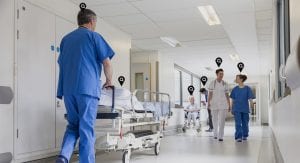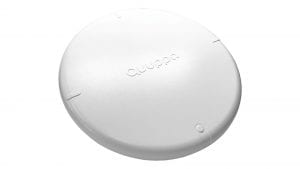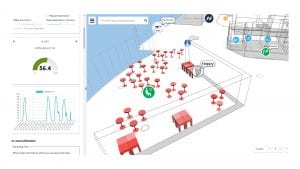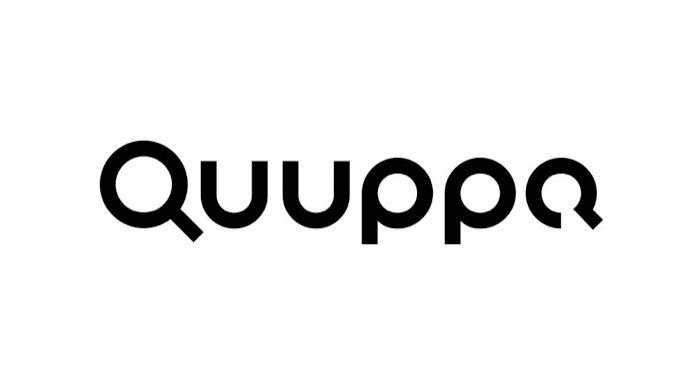
The Quuppa Intelligent Locating System can save lives, as well as time, resources, and money for healthcare facilities.
Quuppa, a Real-Time Locating Systems (RTLS) provider based in Espoo, was founded in 2012 with the overarching goal of developing and creating cutting-edge smart indoor location tracking technology. Now, with more than 50 employees, 200 commercial partners, and offices on four continents, Quuppa intends to channel its blend of innovation and collaboration across a broad range of sectors – including healthcare and clinical practices.
RTLS enables users to track people or items in healthcare facilities. For the healthcare sector alone, this can improve the security of facilities, slow the spread of infection, reduce costs and increase the time clinical staff are able to spend with patients. The scalable Bluetooth-powered Quuppa Intelligent Locating System delivers indoor positioning accuracy of around 0.5m; and can be configured to track any Bluetooth-enabled device, be that a physical tag or a smartphone.
RTLS use cases
Hand hygiene
Alongside the ongoing threat posed by the COVID-19 pandemic, the continued danger posed by hospital-acquired infections (HAIs) remains present and pressing – in the US and Europe alone, HAIs kill around 136,000 patients per year. Frequent, thorough hand hygiene protocols form a key part of infection prevention in hospital environments, but a number of studies have indicated that a significant proportion of healthcare professionals either do not perform hand washing and sanitising often enough or as thoroughly as they should.
RTLS within a healthcare facility can reduce that risk by recording the movements of staff between patients, thereby ensuring that if a member of staff either does not stop at a sink before and after meeting with patients or makes too brief a stop, the issue can be flagged and the healthcare worker can be reminded by a haptic or audible alarm. Not only does this allow administrators to address poor hand washing practice at the source, but staff are more likely to perform the proper hand hygiene protocols.
The use of an accurate RTLS system for hand hygiene processes is beneficial for multiple parties: firstly, it means that fewer patients will contract infections during their stay. Fewer infections means shorter stays and thus improved turnaround for the healthcare facility. In the US, furthermore, fewer hospital-acquired infections mean lower costs to the patient, as healthcare insurance may not cover all costs. “We are very excited to see that our technology has been successfully tested and implemented by our partners to significantly increase the hand hygiene compliance and help save lives,” says Christoffer Segercrantz, VP Sales at Quuppa.
Saving money
A functional asset tracking system can save healthcare facilities not only staff hours and resources, but also money. The loss of equipment which has not been comprehensively tracked may incur substantial costs. By maintaining a continuous oversight of stock levels – particularly medicine and other consumables, including disposable personal protective equipment (PPE) – administrative staff are able to avoid unnecessary duplicate orders and stock losses.
Saving lives
Administrative and procurement professionals within healthcare facilities face a number of singularly challenging obstacles, ranging from insufficient budgets to the fact that – unlike most other sectors – asset loss can cause genuine harm to patients, and in some cases can even hasten a patient’s death. The expiry date of medicines, particularly those with a short shelf life or which are not commonly in use, must be monitored assiduously, as must the temperature of some medications. Single-use tools and equipment for use in lifesaving procedures must be kept well-stocked, for example in the case of emergency crash carts. Meanwhile, monitoring the location and status of equipment and medical devices is a necessary drain on staff hours. With the burden of supervising and adjusting stock levels reduced, clinical staff are free to spend more time with patients.
Improving workflows and silos
Another significant issue within hospital procurement is that of siloed departments and sectors: disparate departments within a single facility may not communicate with each other. This can lead to duplicate orders or stock disparities between departments. Some hospitals have stowed away unused beds in storage spaces, only to reorder unnecessary additional beds due to a failure to communicate.
Establishing a single collaborative platform through which each department can view stock levels and locations through the whole facility enables different procurement teams to share resources, communicate item losses and retrievals, and construct a hospital-wide procurement plan to optimise the deployment of existing assets and the sourcing of new ones.
Patient and staff safety
By necessity healthcare facilities host a potent combination of vulnerable patients, patients in physical or mental distress, and volatile or intoxicated patients; along with a great deal of expensive equipment and strong medications. More recently, alongside all this, doctors and nurses have reported a growing number of patients displaying physical and verbal aggression relating to the COVID-19 pandemic, with some becoming agitated by the suggestion that they wear a mask and others denying that the virus exists at all or refusing treatment.
In order to protect patients and staff members, secure spaces must be strictly defined and maintained. Access control measures, whereby certain doors can only be opened with a staff ID equipped with an electronic tag, can shore up the safety and security of staff and patients. These measures are particularly useful in maternity wards to assuage the risk of child abduction; as well as in preventing the spread of infection between hospital departments by limiting the space in which potentially contagious patients can roam.
The safety of patients must remain a key priority: by equipping each patient with an RTLS-tagged alarm button, which triggers an alert if the patient falls, experiences distress or if their condition worsens. Similarly, when healthcare workers are able to access location-tracking panic buttons, the respondent is able to see immediately exactly where to direct help or support.

Quuppa in partnership
Use case: Essity
Global hygiene and health firm Essity, described as a ‘global shaper’ of the hygiene market, distributes its products in around 150 countries worldwide. Tork, the workplace hygiene arm of Essity, has partnered with Quuppa as part of its mission to transform hand hygiene and the prevention and control of HAIs.
“We want to do our part when it comes to healthcare; and the obvious first step is hand hygiene, because it is so important,” explains Håkan Lindström, Global Technical Innovation Manager for Tork Services. “Hand hygiene is one of the biggest weapons against HAIs, but hospitals commonly measure hand hygiene compliance by observing it manually, which means they do not get an accurate measurement because the subjects know they are being observed.
“We want to measure hospital employees’ hand hygiene compliance in a very precise and objective way, to help them improve their hand hygiene; and by extension to decrease the number of infections in healthcare spaces. Quuppa has been a great help, because its indoor positioning system allows us to track nurses with a very high level of precision – one that nobody else in this particular market can replicate – and it also allows us to be very flexible when it comes to establishing rules and standards. Using Quuppa’s location tracking technology we can track the movement of nurses and the corresponding levels of hand sanitising in nearby dispensers; and then once we have gathered that compliance data, we can send it directly to the cloud where it can be calculated and assessed.”
Use case: GeoAngel
US-based GeoAngel, which provides services for long-term care facilities such as group homes and assisted living, teamed with Quuppa on a crucial safety initiative. GeoAngel Product Executive Derek Stiver tells HEQ: “One of the key services which is needed in our field revolves around the ability to know exactly where elderly residents are. The classic scenario is with patients who exhibit dementia and Alzheimer’s symptoms. Upon awakening, a resident may be disoriented due to short-term memory loss. However, they remember where ‘home’ is, because their long-term memory is still intact. So they do what is very natural: they attempt to go home. It is completely normal, completely natural; and extraordinarily dangerous for everybody involved. When a resident leaves, it is termed an ‘elopement’ which has financial repercussions for the operator of the facility.
“The traditional solution to that problem has involved some variation of locking everybody in the building,” Stiver continues. “In some senses this is necessary – it’s unpleasant for everybody involved: the staff, the residents, the families all dislike it, however necessary it is for patients’ safety.
“The ability to use an interior positioning system in combination with GPS has allowed us to get rid of all of these locks, because now we can track where people are. If they become confused and try to leave the building, the location tracker will set off an alarm so that staff know what has happened and can go and bring the patient back to a place that is safe, without turning the nursing home into a prison.” This is vital in the US as these facilities are at risk of losing federal and state funding if they experience even a low number of resident elopements.

Use case: Haltian
Haltian is a global player in the field of commercial Internet of Things (IoT) technology. Alongside Quuppa, Haltian has been trialling its digital hospital twin at the ‘Smart Care’ testing laboratory in Stavanger, Norway. “Quuppa demands the initial infrastructure commitment, but once it is installed, it will run forever,” comments Haltian Head of Hospital Business Sector Gunnar Hansen. “With Quuppa’s accurate indoor positioning system, we are able to visualise the location of people and assets in our Emphatic Building digital twin in such a way it immediately adds value to our customers.”

Hansen adds: “Quuppa tracking technology delivers a big advantage. If I were to build a new building and I wanted an accurate, stable tracking platform, it is the system I would personally choose. The team is experienced; the product is reliable; and it is a leader in terms of accuracy. Of course, the need for precision differs between different parts of the hospital – in some departments or wards accuracy of 15cm would not be necessary and a metre would be enough, but in some parts, that increased level of accuracy is critical.
“One of the primary benefits of indoor positioning in the field of empathic building for hospitals is its application to contact tracing: if a person becomes infected, the tracking system can let you know if they have been in contact with another person – but what it can also do is determine where medical equipment has been and which patients have used it. If a patient is rolled into the hospital in a wheelchair, put to bed, the wheelchair is pushed somewhere else and a new patient is put into that wheelchair; and then the first patient is diagnosed with COVID-19, then the hospital needs to know where that wheelchair is now and who has used it since that first patient.”
Use case: NESA
NESA Solutions, a US-based solution provider since 2013, aims to harness the power of precision location to revolutionise the way in which the healthcare sector and numerous other industries can visualise and execute their workflows. COVID-19 has fundamentally changed the business landscape, transforming technological innovations from a nice-to-have to a must-have, in order to successfully navigate the need to balance health and safety with productivity and efficiency. NESA’s applications – which range from combating the spread of infection with highly accurate contact tracing and quarantine monitoring; to implementing and enforcing precise hand hygiene protocols which follow the World Health Organization’s Five Moments of Hand Hygiene; to tracking people and assets in real time; to monitoring inventory within the supply chain; to keeping infants safe; to eliminating the potentially dangerous wandering of our elderly population; to deploying our award-winning crash cart inventory and location-based regulatory survey modules – are designed to capitalise on this critical need.
“As one of Quuppa’s original partners since 2013, we knew pretty quickly that their dot was a game changer,” says Neil Salem, CEO and founder of NESA. “Our mission was to take that dot and create a platform around it that would enable organisations to automate and improve their workflows. Starting out in the healthcare space, we quickly realised that our platform can be utilised in any industry, so we made numerous enhancements to it; as a result, today, our platform is being utilised by some of the largest companies around the world, in over 20 different industries.”
This article is from issue 16 of Health Europa. Click here to get your free subscription today.









